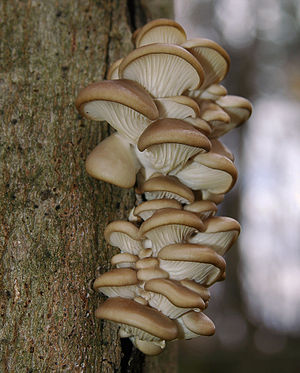Oyster mushrooms
| Oyster mushrooms | ||||||||||||
|---|---|---|---|---|---|---|---|---|---|---|---|---|

Oyster mushroom ( Pleurotus ostreatus ) |
||||||||||||
| Systematics | ||||||||||||
|
||||||||||||
| Scientific name | ||||||||||||
| Pleurotus | ||||||||||||
| ( Fr. ) P. Kumm. |
The oyster ( Pleurotus ) are a fungal genus of the family of Seitlingsverwandten . In the past, they were long attributed to the stem porling relatives (Polyporaceae).
features
The mushrooms are mainly short-stemmed to sessile mushrooms that have grown on the side of the substrate . The hats are shell, kidney or semicircular. The underside of the hat is formed by bright, whole-rimmed lamellas , the top of the hat is bare and not flaky. The meat has in young fruiting bodies a juicy, old soon a chewy consistency. The spore powder is white to pale clay in color.
Generic delimitation
There are also species in other types of mushrooms that form fruit bodies comparable to the mushrooms, with short or sessile stems attached to the substrate, and are sometimes also referred to by the common German name Seitling. In Central Europe, these are the panellus ( Panellus ) Shell rings ( Hohenbuehelia ) tangle Inge ( Panus ), the species designated also as oyster Pleurocybella and Phyllotopsis . The relatively large elm rasp ( Hypsizygus ulmarius ) and other wood rasp could also be confused with the mushrooms.
ecology
The species of the genus Pleurotus live as saprobionts or (weakness) parasites. Individual species can appear both as weak parasites and as saprobionts. Most of the mushrooms live on hardwoods, conifers are less common. The king oyster mushroom is an exception: it parasitizes on the roots of umbellifers . The opuntia mushroom ( Pleurotus opuntiae ) decomposes the cellulose and the vascular bundle wood of agaves and cacti. The wood-dwelling mushrooms are white rot pathogens , i. In other words , in addition to cellulose , they can also break down the wood pulp lignin .
species
The genus Pleurotus includes around 30 species worldwide. Eight species occur in Europe or are to be expected there.
| Oyster mushrooms ( pleurotus ) in Europe |
Other species are cultivated as edible mushrooms and are sometimes marketed under fantasy names:
| German name | Scientific name | Author quote |
|---|---|---|
| Lemon yellow or lime mushroom | Pleurotus citrinopileatus | Singer 1943 |
| Abalone mushroom | Pleurotus cystidiosus | OK Miller 1969 |
| Rose mushroom | Pleurotus djamor | (Rumphius 1750 ex Fries 1821) Boedijn 1959 |
Veiled poplar mushroom
Pleurotus calyptratusLemon yellow
mushroom Pleurotus citrinopileatusRill-stalked mushroom
Pleurotus cornucopiaeRose
mushroom Pleurotus djamorBarked mushroom
Pleurotus dryinusPale herb mushroom
Pleurotus nebrodensisOyster mushroom,
Pleurotus ostreatus
meaning
ingredients
In 1951 an antibiotic substance called pleuromulin (or also called pleuromutilin ) was isolated from this fungus. Today, chemical modifications of this substance are used for various therapeutic purposes. A well-known active ingredient in drug therapy is tiamulin or tiamulin hydrogen fumarate.
Food value
Most species are considered edible and tasty, especially the oyster and king oyster mushrooms . Some mushrooms have gained economic importance as cultivable edible mushrooms because they can colonize a variety of substrates.
Origin of name
The botanical name Pleurotus is derived from the Greek pleura = the side, and the Greek us = the ear. Because the mushrooms are often ear-shaped and have a side stalk.
swell
literature
- A. Bresinsky: Snow cap mushrooms - oyster mushrooms. In: Der Tintling 4/2006, pp. 8-18, ISSN 1430-595X
- P. Albert and G. Albert: Culture mushroom king oyster mushroom (Pleurotus eryngii). In: The Tintling. 1/2007, pp. 60-61, ISSN 1430-595X
- Josef Breitenbach, Fred Kränzlin (Ed.): Mushrooms of Switzerland. Contribution to knowledge of the fungal flora in Switzerland. Volume 3: Bolete and agaric mushrooms. Part 1: Strobilomycetaceae and Boletaceae, Paxillaceae, Gomphidiacea, Hygrophoracea, Tricholomataceae, Polyporaceae (lamellar). Mykologia, Luzern 1991, ISBN 3-85604-030-7 .
- German Josef Krieglsteiner (Ed.), Andreas Gminder : Die Großpilze Baden-Württemberg . Volume 3: Mushrooms. Leaf mushrooms I. Ulmer, Stuttgart 2001, ISBN 3-8001-3536-1 .
Individual proof
- ↑ Eric Strittmatter: The genus Pleurotus . In: fungiworld.com. Mushroom Taxa Database. February 10, 2005, accessed August 4, 2012 .
Web links
- Pleurotus Genus Record in the Index Fungorum






